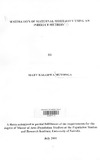| dc.description.abstract | The World Health Organization (WHO) defines maternal mortality as a death
during pregnancy or within 42 days afterward, from causes related to or aggravated by the
pregnancy or its management. At least 600,000 women die annually from pregnancyrelated
causes. Complications of pregnancy, childbirth, and unsafe abortion are now the
leading killers of women of reproductive age throughout the Third World. (WHO, 1992).
The exact extent of maternal death and its causes often cannot be determined
because of poor data quality and incomplete reporting in most developing countries. Data
sources for maternal mortality measurement include hospital records, population-based
studies and vital registration systems. In Africa, there is a common problem of poor or
non-existent vital registration systems leading to reliance on sample surveys to get
maternal mortality data and estimates. It is because of this that Graham et al, (1989)
developed the sisterhood technique for deriving maternal mortality estimates in places
with limited or defective data.
Kenya as a nation has tried to improve its data collection methods and there are
demographic surveys (KDHS) undertaken every five years to collect reproductive health
information on the population. The latest KDHS included the DHS maternal mortality
module from which the direct sisterhood method developed by Rutenberg and colleagues
in 1990 was used to estimate maternal mortality. This study has used the 1998 KDHS and
the indirect sisterhood method to provide maternal mortality ratios for Kenya. The study
uses the Women's Questionnaire in which 7,881 women aged 15-49 years old were
successfully interviewed and these reported 237 maternal deaths.
The study objective was to use the same data set (1998 KDHS) and the indirect
sisterhood method to derive maternal mortality estimates for Kenya at the national and
sub national levels. The second objective of this study is to provide maternal mortality
differentials for Kenya. The study therefore provides maternal mortality ratios by various
background characteristics of the respondents' namely: region of residence, type of place
of residence, religion, and ethnic grouping. The maternal mortality ratios derived by the
indirect sisterhood method relate to a period of 12 years before the survey. The
interpretation of these results needs to be cautious SInce the characteristics of the
deceased woman may not necessarily be similar to that of the respondent reporting.
The study found a national maternal mortality ratio of 500 maternal deaths per
100,000 live births for the period 12 years before the survey. This national estimate had a
wide confidence interval ranging from 475 to 613 maternal deaths per 100,000 live births.
The results of this study indicate that there are wide maternal mortality differentials in
Kenya, with Western, Coast and Nyanza Provinces having very high maternal mortality
ratios ranging from 600 to 900 maternal deaths per 100,000 live births, and very high
lifetime risks of maternal death such as 1 in 15 women from Western Province facing the
risk of a maternal death in her lifetime. Central Province seems to be one of the lowest
maternal mortality risk areas of Kenya. Residents in urban areas of Kenya are more likely
to report a higher incidence of maternal mortality than their rural counterparts are. Based
on the sisterhood estimate, urban areas in Kenya have a ratio of 900 maternal deaths per
100,000 live births compared to a ratio of 500 maternal deaths per 100,000 live births in
rural areas. Catholic and Protestant respondents are more likely to report lower maternal
mortality compared to their Muslim counterparts.
The study concludes that the measurement of maternal mortality is a problem
since the available data sources are wanting. In this study, the sisterhood module has been
used but difficulties have arisen since the socio-demographic characteristics of the
deceased woman are not available, hence the findings may not be representative of the
true population levels and trends of maternal mortality. Therefore, the study recommends
that a surveillance system should be put in place to validate the results of the KDHS
findings on maternal deaths incidence and also to provide baseline data on maternal
mortality in the country so as to strengthen research in this important area of reproductive
health in Kenya | en |

